For many of us in four-season geographies, the end of summer and fall marks the end of RV season, too. And if you’re not a full-time or snowbird RVer, you’ll need to make arrangements for storing your RV. Even during the warmer parts of the year, finding proper RV storage is one of the most effective preventative steps you can take to maintain your RV and its value.
As a seasoned RVer who has done everything from full-timing to occasional weekend camping trips during the summer, I’ve had a variety of RV storage experiences. In this post, I cover common questions about RV storage, along with a few tips I’ve learned along the way.
What Are My Options for RV Storage Facilities?
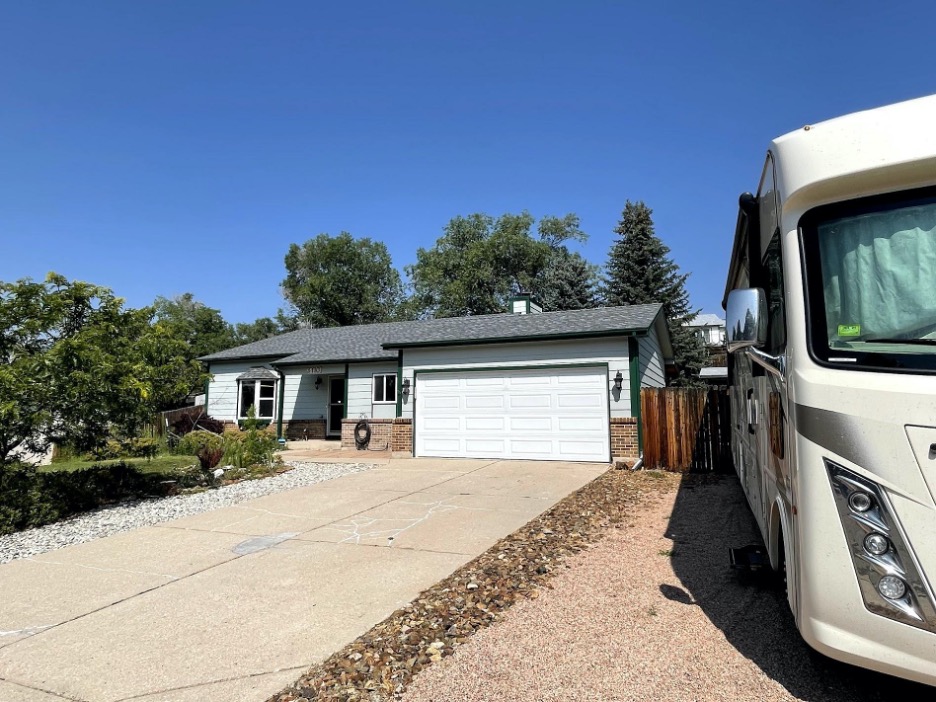
Image: Lindsay McKenzie
When it comes to where you can store your RV, you really have two main options: store the RV on your own property or pay to store it on someone else’s property.
To determine whether or not you can store your RV on your own property, you’ll need to first check with your homeowner’s association or determine if there are any neighborhood covenants that restrict residents from parking RVs on their property. Conducting a search for ‘what zoning is needed for RV storage’ in your region can also help you determine if you can store your RV at home, or if it’s possible to construct your own RV storage facility on your property.
If you don’t have any restrictions, you’ll then want to determine if you have a space on your property that is both large enough and secure and safe enough for your RV. Theft, access, damage, and weather are all concerns.
If storing your RV on your own property isn’t an option, you’ll need to look elsewhere. The simplest solution might be to see if a friend or a family member has the space and would allow you to park your RV on their property. For those with moderate-to-large RVs, this isn’t necessarily an easy favor to ask family and friends — your RV may take up considerable driveway space — so consider proposing a monthly payment for the use of their space for those who seem reluctant. This may still prove to be far cheaper than paying for commercial RV storage. If not, commercial storage it is.
Do a quick internet search for RV storage facilities in your area to get started. With RV sales on the rise in recent years, more storage facilities are popping up across the country. If there aren’t any close enough to you, or you want to compare options, you may also find that standard non-RV storage facilities sometimes allow RVs to be stored on their property. (Some even have storage units large enough to park an entire motorhome inside!)
Check with your local RV parks, too, as some offer storage. You’ll need to weigh out your options and determine which one fits your needs and budget.
How Much Is RV Storage?

Image: Lindsay McKenzie
How much does it cost to store an RV? The different storage options listed above will vary greatly in cost and amenities. Obviously, storing your RV on your own property or a friend or family member’s property is the least expensive option. But will you have coverage? Is the area gated and safe? Will you retain 24/7 access to your RV if you want to check on it, or even dewinterize it for a trip to a warmer climate?
Even when it comes to storing your RV at a storage facility or RV park, where these issues are more deliberately addressed, there are still a variety of factors that influence the cost.
First, the prices of RV storage will fluctuate depending on your location and the availability of storage in your area. The amenities a facility offers also influence the cost. Some facilities have covered spots where the RVs are parked underneath roofing, while others offer full coverage where the RVs are parked inside of an enclosed unit similar to a garage.
Then, of course, others only have an open field or parking lot that may or may not be paved, where RVs are simply parked side by side in the elements. Security, 24/7 access, and on-site dumps and freshwater filling stations will also affect a storage facility’s pricing. Short-term versus long-term RV storage is also a consideration. You may find storage facilities will charge more for a shorter length of time. Some may even require you to store your RV with them for an extended amount of time versus allowing you to pay month to month.
Each facility will have its own policies, contracts, and payment terms. Consider all the pros and cons of each facility in addition to the cost.
What is the Average Cost of RV Storage?
The average cost of RV storage ranges from around $50 a month to hundreds of dollars a month. However, your monthly price will vary based on many factors, such as your location, the duration of storage, your RV’s size, covered versus uncovered storage, indoor versus outdoor storage, urban versus rural locations, and the amenities/services provided by the storage facility.
While shopping for the best rates, make sure you get what you pay for. If a facility is charging a high monthly rate, you should expect security, protection from the elements, or even indoor accommodations.
How To Prepare an RV For Storage
If you don’t store your RV in an enclosed storage facility, you’ll certainly want to determine what elements you’ll need to protect against (including hailstorms). Here are a few tips for storing your RV outdoors during extreme weather conditions:
How To Protect Your RV from Sun Damage in Storage
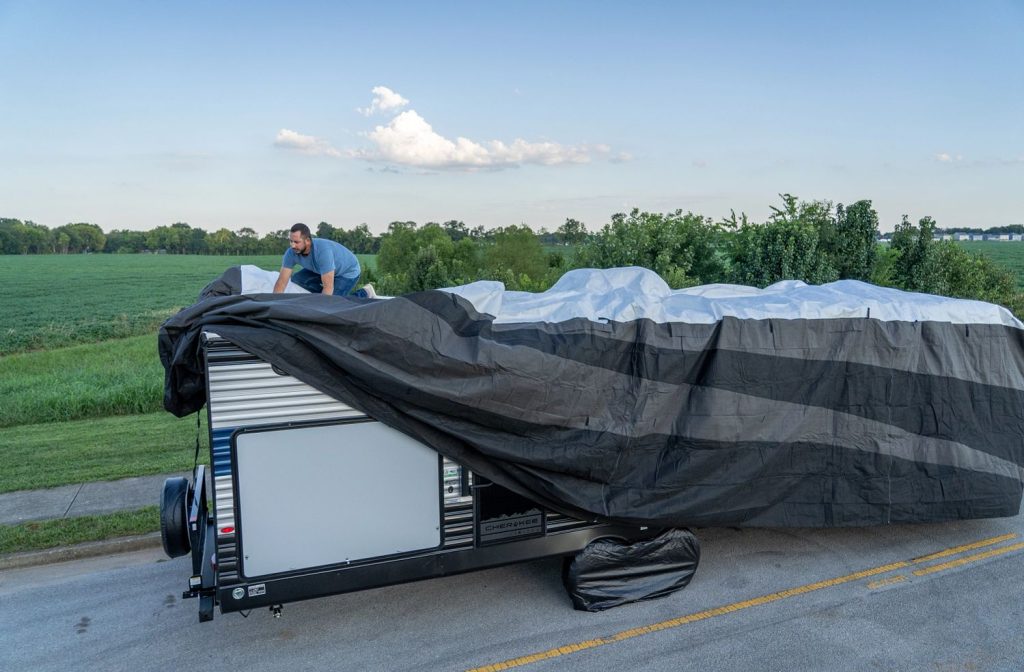
Regardless of whether you’re storing your RV outdoors during the heat of summer or in the freezing temperatures of winter, one of the biggest concerns is protecting the exterior of your RV. Getting an RV cover will protect it against sun damage, as the sun can fade the paint or decals on your RV.
If you don’t have an RV cover, you’ll want to make sure you wash the exterior of your RV to keep any dirt from eroding the surface, as well as wax your RV to help seal and protect it. The sun can also crack, harden, and damage the rubber on your tires, so if you choose not to cover your RV, you should at least consider getting tire covers.
Here are a few more important resources that will help you learn everything you need to know about protecting your RV’s exterior from the elements:
- Why Should You Cover Your RV?
- What Are Your Options For Keeping Your RV Covered When Not In Use?
- How To Install an RV Cover
How To Keep Your RV Battery Charged in Storage
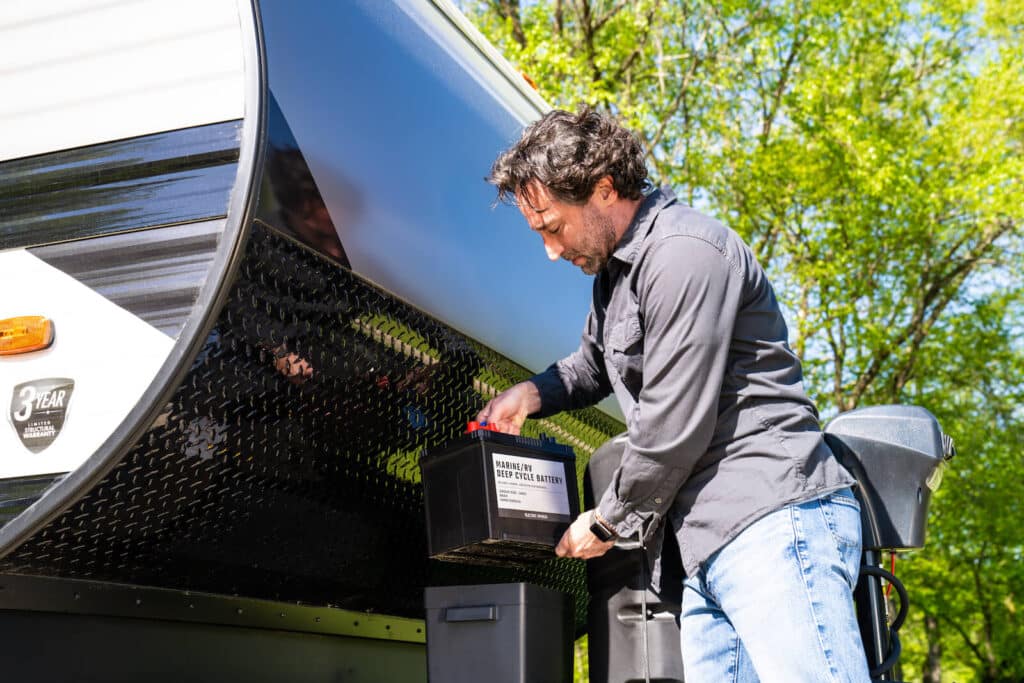
Photo by Camping World
Your RV’s coach battery is another component that needs to be protected in extreme temperatures. Anytime your RV will be sitting for a long period of time, it’s good to disconnect your battery to avoid draining it. You’ll also want to store your battery inside your home or a climate-controlled garage to avoid exposure to excessive heat or cold. This also includes any batteries you may have in other parts of your RV, such as clocks, flashlights, alarms, etc.
If your RV will be stored for more than 30 days, you’ll need to periodically charge your battery to keep it from draining. If you don’t remove your RV battery, which we do recommend, you’ll at least need to ensure that your Battery Disconnect Switch is changed to the Off position to prevent parasitic draws.
Learn more about RV batteries and proper battery maintenance in this guide.
How To Protect Your RV in Freezing Temperatures in Storage
The most important thing is that you properly winterize your RV before temperatures consistently dip below freezing. Your unit’s manual will provide some instructions for winterizing your specific model, but it’s always smart to research or ask a service technician for tips and guidance, as each RV is different when it comes to winterizing.
The important thing is that you ensure there is no water in any of the pipes or holding tanks to prevent freezing and cracking. If you choose to winterize with RV-safe antifreeze, be sure to bypass your water heater to avoid damage. Learn everything you need to know about RV antifreeze to ensure you safely and adequately prepare your RV for freezing temperatures in storage.
How To Keep Moisture Out of Your RV in Storage

Image: Paul Maguire via Shutterstock
Depending on where you plan to store your RV, you’ll need to pay attention to whether you’ll need to increase or decrease the humidity inside your RV. Humidity and moisture can wreak havoc on an RV. Alternately, especially dry climates can cause components to crack.
If your RV will be stored in a dry climate, increase just enough moisture to keep any wood from drying and cracking. One common practice is to place a large bucket of water in the center of the RV, to add some moisture to the air through natural osmosis.
On the flip side, you may need to absorb excess moisture from the air if your RV is stored in a moist and warm climate. Using a dehumidifier will help prevent mold and mildew growth inside the RV. Be sure to open all cabinet and closet doors when trying to balance the humidity or dryness in your RV to keep the air consistent throughout the unit.
Learn more in our complete tutorial on keeping moisture and condensation out of your RV.
How To Keep Mice Out of Your RV During Winter Storage
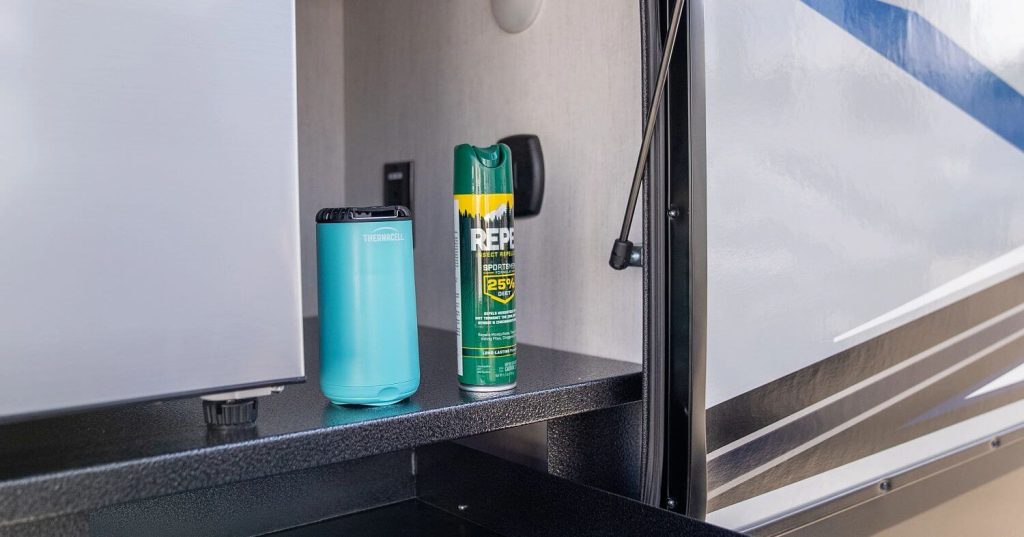
Photo by Camping World
Pests and rodents can be one of the biggest concerns when it comes to damage to your RV while storing it. They seek warm shelter during the colder months, and an RV sitting idle on the side of your home in a storage facility is especially attractive. While an enclosed RV storage facility reduces the risk of pest and rodent damage, it can’t eliminate it entirely. So here are a few more steps you can take:
- Ensure that your RV is clean and that no food, or even small particles, are left behind.
- Thoroughly wipe surfaces and vacuum all carpeted areas.
- Inspect every area of your RV for possible entryways and try to seal them where you can.
There are many home remedies to deter rodents from entering your RV, including mothballs, dryer sheets, and even Irish Spring bar soap. However, sometimes the old-fashioned mouse traps are the way to go. To keep insects away, a good (and natural) home remedy is to soak cotton balls with lavender oil, cedar oil, tea tree oil, and/or peppermint oil and place them all around the inside of the RV. For ants, baits and powders tend to do the trick.
Explore our collection of repellants and pest control products for your RV.
How To Ensure Your RV’s Security in Storage
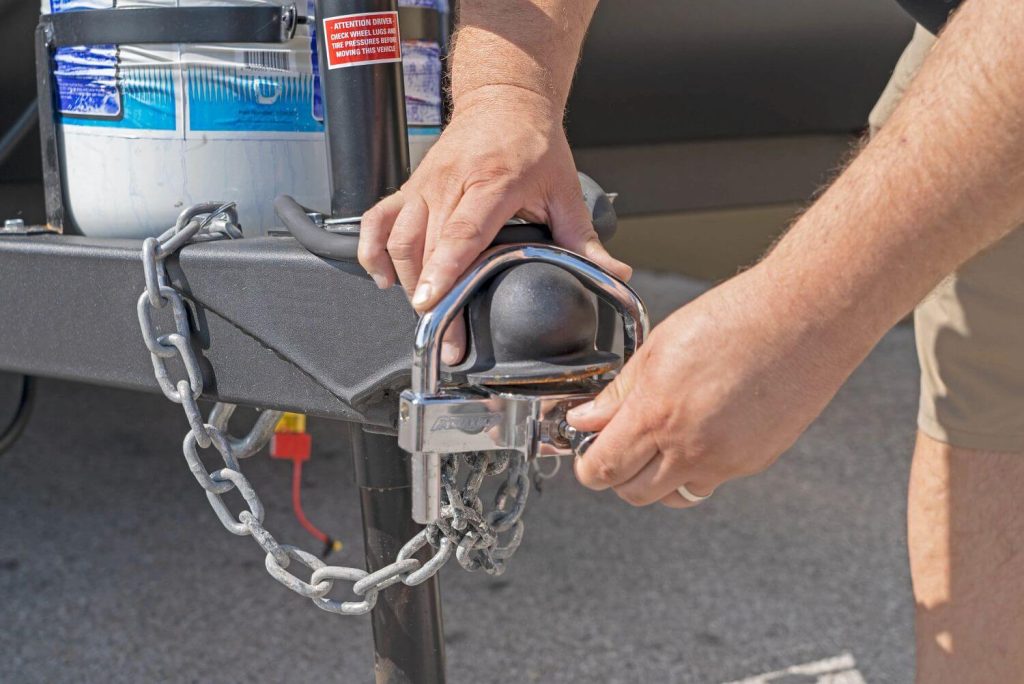
Photo by Camping World
Of course, critters aren’t the only things wanting to get inside your RV. You’ll need to be prudent about locking the doors, windows, and exterior storage compartments of your RV and taking other security measures to avoid theft or break-ins. Wheel locks and hitch locks prevent your RV from being stolen. But other products like motion-detecting lights and alarm systems and upgrading to higher quality locks may be a good idea for added security.
Learn more in our complete tutorial on improving your RV’s security, both for storage and in camp.
Other RV Storage Hacks

Image: Camping World
- Make sure everything is turned off in the RV, such as the propane, water pump, and refrigerator (you’ll need to defrost the freezer first by turning it off and laying a towel inside to absorb the water).
- You may want to consider combatting odors inside your RV. One way to do this is to allow for adequate airflow through the RV by opening vents just enough to circulate air but not so much that rain or snow can get in.
- It’s wise to check in on your RV every so often to make sure the preventative measures you’ve taken are working.
- Cleaning the air conditioning filters and covering your air conditioner can help protect it from the elements.
- If you own a motorhome and it will be in storage for an extended amount of time, you’ll want to start and run the engine about once a month to keep the engine components lubricated and prevent the fuel from deteriorating. Another option: add a fuel stabilizer to your fuel tank, which can also be used in your generators.
Taking these steps to ensure your RV is stored safely and properly, and stocking up on must-have products for storing your RV, will surely help protect your home on wheels when you aren’t using it. Then, when the time comes, your RV will be ready for your next adventure!
If you want to avoid storing your RV, I’d highly recommend renting it out instead by using the Good Sam rental program. You can not only avoid the hassle and costs of storage, but you can make money when you’re not using your RV.
How do you store your RV? Tell us in the comments below!
The post Camping World’s Guide to RV Storage appeared first on Camping World Blog.
By: Lindsay McKenzie
Title: Camping World’s Guide to RV Storage
Sourced From: blog.campingworld.com/learn-to-rv/camping-worlds-guide-to-storing-an-rv/
Published Date: Fri, 03 Nov 2023 08:00:00 +0000
---------------------------------------------
 CampingSurvivalistHuntingFishingExploringHikingPrivacy PolicyTerms And Conditions
CampingSurvivalistHuntingFishingExploringHikingPrivacy PolicyTerms And Conditions
